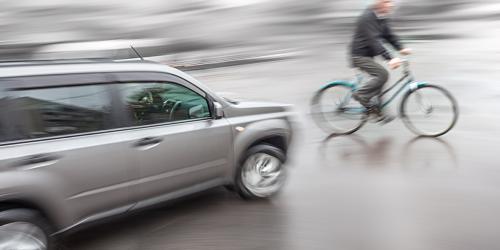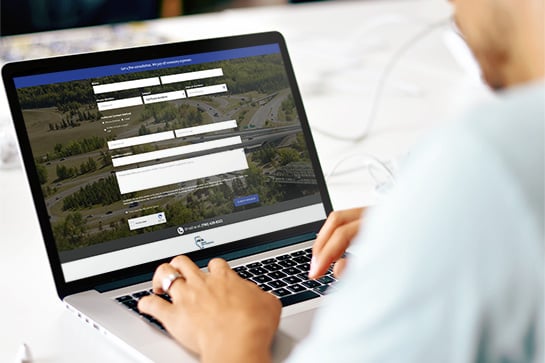June is bike month in Edmonton, when the City encourages everyone to enjoy the benefits of physical exercise, exposure to the great outdoors, and pure fun by increasing the amount they bike, whether for recreation or as transportation to school or work. Along with the benefits of biking come some potential hazards, however, and it is essential to keep safety in mind at all times. As experienced plaintiffs’ personal injury lawyers we offer the following insight into factors that affect liability (who’s at fault) for a cycling accident and some tips to ensure that you and your family have a safe and happy biking experience.
What affects liability and damages in a bike accident situation?
Usually, a plaintiff (the injured person) has to burden to prove that the defendant was negligent and caused their injury. However, the law is a little different when it comes to collisions between cars and cyclists.
When a driver hits a cyclist, the law presumes they are negligent unless they can prove other factors contributed to the accident. This is called the reverse onus.
In some cases, the driver’s lawyer may argue that the cyclist shares the blame for their own injuries if the cyclist failed to take reasonable steps to look out for their own safety. If the cyclist is found to have contributed to the accident the court can divide the responsibility for the crash on a percentage basis, e.g., 75/25 or 50/50. What this means for the cyclist is that he or she may end up with a reduced damages award.
Factors that affect whether a cyclist may share fault for his or her own injuries
- Were you wearing a helmet? Would it have made any difference to preventing your injury?
- Were you “distracted riding” or wearing earbuds while riding so that you couldn’t hear traffic horns?
- Did you break the law while riding? For example, blow through a stop sign or red light? Riding in the in the middle of the road, weaving in and out of traffic?
- Were you adequately visible to drivers (e.g., riding at night without a light)?
- Were you following the rules of the road?
Learn more about what factors affecting liability in bicycling accidents.
Things you should do after a cycling accident
- Get medical attention and even if you don’t think your injuries are serious, let your doctor decide that. Sometimes, the onset of symptoms is delayed. It’s also a good idea start to document your injuries and how they are affecting you right away.
- Try to stay calm and gather as much information as you can from the driver who hit you (name, contact details, insurance information) and any witnesses. If you are seriously injured, don’t worry about this step. The priority is always to attend to your injuries.
- If an ambulance takes you to the hospital, take the time to get checked out properly.
- Don’t offer an apology to the driver and don’t discuss who was “at fault.”
- If you’ve got your phone with you, take a photo of the car license, the car, the damage to your bike and equipment, the accident scene and your injuries.
- Don’t leave the scene until the police arrive. Get the accident report number.
- If possible get some legal advice before you talk to your insurance company. Most personal injury law firms, including CAM LLP, offer a free consultation. You should take advantage of that.
If you are injured but don’t end up in a hospital, or you are discharged from the ER without being admitted, after you get home:
- Write out the timeline of events leading to your accident and what happened. It’s best to do this while it’s still fresh in your mind.
- Draw a diagram, note the direction you were moving and where the car was traveling from when it hit you. If you were thrown from your bike, mark where you landed in relation to the site of impact.
- Describe the road and weather conditions and note any other factors that might have affected visibility. Make a note if you had a working light and reflective gear if the accident occurred at night.
- Photograph damage to your bike and gear but don’t throw away damaged equipment.
- List all your injuries, don’t leave anything out, but don’t exaggerate either.
Of course, preventing a bike accident is by far the better option. What follows are some handy safety tips divided by age group.
Safety Tips for Toddlers and Younger Children
- Don’t make the mistake of buying a bike your child can grow into. Make sure it is the correct size. Your child should be able to sit comfortably on the seat with his or her feet on the ground-otherwise it will be difficult for your child to balance.
- Make sure that your child wears a bicycle helmet that meets safety standards, is specially designed for biking, and is fitted correctly.
- Model good behaviour by wearing your helmet at all times when biking with your child.
- Your child will probably need training wheels, to begin with; make sure that they are mounted correctly and are in excellent condition. Check that the training wheels are tight and secure each time your child goes for a bike ride.
- Be sure that your child is visible by dressing them in bright colours and use reflector tape on their clothing.
- Make sure your child’s bike has a bell, and reflectors, front and back.
- Keep your child’s bike well maintained, with the handlebars and seat tight, the chain oiled, the tires properly inflated, and the brakes in working order.
- Make sure that your toddler or young child bikes only in safe areas, such as playgrounds and bike paths, and that they do not venture out onto the roadway without you.
- Don’t let your toddler or young child ride at night.
- Teach your child the standard rules of the road, like the meaning of traffic signs and signals, and the common bike hand signals. You may want to consider getting them biking lessons.
- Always closely supervise your toddler and young child when they are on their bike.
Safety Tips For Older Children And Adults
- Always follow the rules of the road.
- Cyclists must stop at all red lights and stop signs and obey other posted signs and traffic signs, obey lane markings, and obey the speed limit, just like a car.
- Always ride predictably, in a straight line, and do not swerve within a lane, or in and out of cars.
- Clearly signal your moves to others on the road well in advance. Cars can’t stop on a dime.
- Announce your approach to another cyclist or pedestrian by voice (for example, “On your left”) and by ringing your bell.
- Be alert at intersections, where collisions frequently occur.
- When crossing at an intersection, always dismount and walk, so that you are afforded the greater legal protections given to a pedestrian in a crosswalk, (as opposed to a vehicle).
- Ask yourself if you can reach your destination by way of a bike path or designated bike lane, rather than traveling with the cars on the roadway.
- It is mandatory that a helmet is worn at all times when biking. Make sure that your helmet meets the required safety standards and fits securely. (helmets are NOT mandatory for adults in Alberta. They should be but they aren’t- we could ceetainly mention that people SHOULD wear helmets, though).
- Make sure that your bike is outfitted with a bell or horn, a white headlight and a red taillight, reflectors on the front and back of the bicycle and has working brakes.
- Distracted driving laws apply equally to cyclists and motorists, so make sure that you are not talking on the phone when biking!
- Take care when you are listening to music on headphones, as they may make it difficult to be fully aware of your surroundings, and possible hazards.
- Always ride on the right side of the lane, with the flow of traffic, and in a single file with other cyclists (not two or three abreast, for example).
- Keep an eye out for parked cars so that you are not “doored” – hit or dislodged from your bike by a car opening a door in front of you.
- Keep a sharp lookout for other road hazards such as potholes, cracks, storm grates, railway tracks, broken glass, gravel, puddles, wet leaves and charging dogs and, if biking with others, alert them to the danger.
- Consider whether you are in a driver’s blind spot, and take extra care.
- Make eye contact with drivers before making a turn or slowing down, and make sure that the driver can see your hand signal.
- Always keep at least one hand on the handlebars to ensure that you are secure. Carry your books and other items in a backpack or bicycle carrier, so your movement is unrestricted.
- As with younger children, make sure that you wear bright colours, so you are visible, especially when riding at night, and consider putting reflective materials on your clothing. A strobing red light attached to your bike, clothing, or helmet is also a good idea.
- Bike with a small toolkit so that you can make minor repairs and be on your way.
We hope you enjoy your biking adventures this summer injury-free!
If you or a loved one is injured while biking, CONTACT CAM LLP for a free consultation, and we can begin steps to set the matter right.

